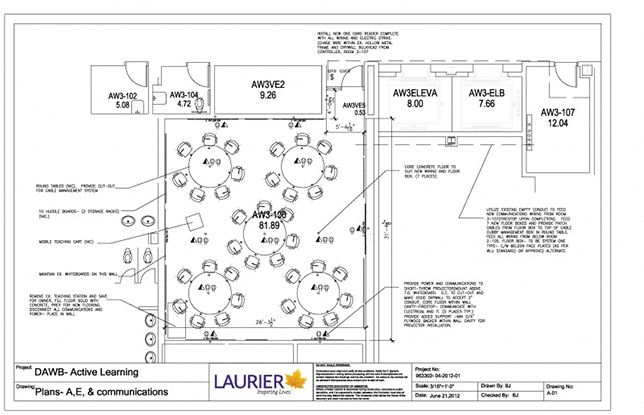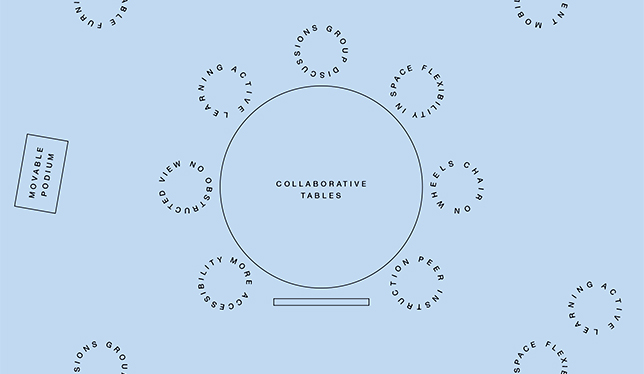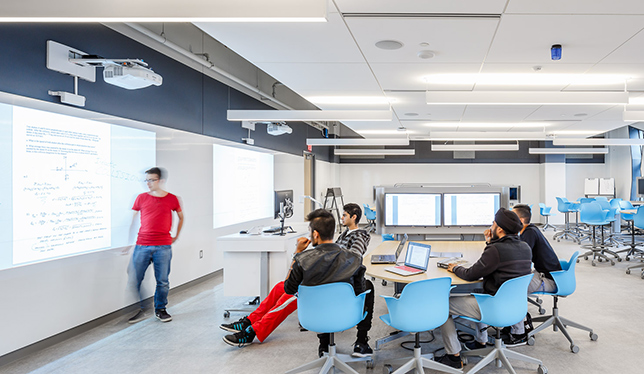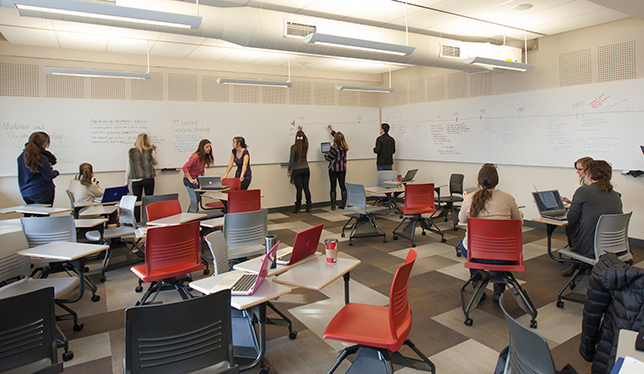Inside Wilfrid Laurier University’s pastel-painted Dr. Alvin Woods Building, a boxy structure on the school’s Waterloo campus that’s home to numerous classrooms and offices, resides what everyone calls the “green room.” It’s a classroom with a tad more fashion sense than your usual institutional space, with bright green walls that match the fabric on the chairs. The chairs, on wheels, are clustered around round tables, each of which is kitted up with a laptop and a pod that can project one’s work to a nearby screen, or all the room’s screens. Between those many screens are whiteboards on each of the four walls. The podium stands sort of at the front, but it hardly seems to matter, since only some students actually face that direction.
“This room gives us permission to teach differently,” says Gavin Brockett, associate professor of history and religion and culture at Laurier. He’s used the green room, which accommodates 40, ever since it opened in 2012. Its arrival coincided with something of a crisis for him in teaching: he was seeing attendance in his classes drop to as low as 40 percent by midterm and was ready to try new techniques to get his students more engaged.

In the green room, Dr. Brockett has had his students do presentations on 16th Century Mediterranean pirates, as well as group projects via videoconferencing with students in Turkey. While it takes more time for him to prep his classes and requires a level of creative thinking he purports to find difficult (“I’m a history professor. I’m out of my league”), he keeps at it. “It’s much more fun to have students show up.” And they do: his midterm attendance rate has soared to upwards of 90 percent, he says.
For Dr. Brockett, this space facilitated a move towards a student-centred teaching style. Many professors elsewhere are promoting active learning – group work, peer instruction, experiential projects and the flipped classroom where students take in lecture-like material at home and use class time for discussions and activities – but their efforts can get stymied within traditional classroom environments. Dragging heavy desks before group work or attempting to get discussions going in large, acoustically challenged lecture halls can be frustrating. “I don’t care how good you are, it’s hard to get groups of six working together in a lecture hall,” says Andrew Leger, an associate professor and educational developer with the Centre for Teaching and Learning at Queen’s University.

One of the pioneers to ponder classroom design is Robert Beichner, now Alumni Distinguished Undergraduate Professor of Physics at North Carolina State University. In the early 1990s, he taught a unique group at NCSU: 36 first-year engineering students who learned in a single classroom while their physics, math, chemistry and engineering professors rotated through. “We used every single research-based teaching method we could come up with,” including group work and internet-based projects, says Dr. Beichner, who taught the physics component. A year later, the university increased the class size to 100, forcing Dr. Beichner and the others to innovate to accommodate the larger group.
In 1995, the school renovated a classroom under Dr. Beichner’s newly created SCALE-UP (Student-Centred Active Learning Environment with Upside-down Pedagogies) protocol. Today, NCSU is in the fourth iteration of such classrooms and Dr. Beichner has a couple decades of data showing what works best. For instance, seven-foot round tables seem ideal, but D-shaped ones are okay for small rooms; chairs should be on wheels, with no arms, and the optimal space between tables is five feet. Students should have access to screen sharing from laptops and whiteboards on walls or on desks.
The Massachusetts Institute of Technology – experiencing a 40 percent attendance rate by end of term in many classes and a 10 percent failure rate – adapted SCALE-UP using input from Microsoft Research to create a techrich classroom for 150 students in 2000. The University of Minnesota looked to both schools and built two classrooms in 2007. Now, Dr. Beichner says the Midwestern school has become a national leader, with a third of its students taking a class in an active-learning classroom each year.
In Canada, McGill University began doing retrofits with active learning in mind starting in 2006. It created a fully active classroom using SCALE-UP ideas in 2009. In 2012, Queen’s started renovating rooms in this style and now has four. The University of Windsor’s Centre for Engineering Innovation opened in 2013 and features numerous active-learning classrooms. University of Lethbridge retrofitted two rooms and completely revamped another in 2014 to follow active-learning principles. McMaster University launched an active classroom in early 2016 and its newly opened L.R. Wilson Hall, a social studies building, has several. Likewise, Université Laval has a number of active learning classrooms and recently opened a new tech-rich teaching space in the faculty of administration that includes a 20-foot-long screen called a VuWall.
Across the country, there are many more. The ne plus ultra: at York University’s new Bergeron Centre for Engineering Excellence, opened this past April, there are no lecture halls – all classrooms are an active learning lab. Adding to these numbers soon will be several spaces in buildings such as Laurier’s Lazaridis Hall, the new home for its business school now under construction, and a proposed science building at U of Lethbridge.
Active learning environments continue to be backed by convincing research. A 2014 review of 225 previous studies of students in STEM disciplines, published in the Proceedings of the National Academy of Sciences, found average exam scores went up by six percent for students in active learning classes while those who learned by lecture alone were 1.5 times more likely to fail.

The benefits seem greater for women and minorities – a big deal for STEM disciplines, where they’re often underrepresented. A 2006 study of Harvard students found interactive techniques erased the gender difference in an introductory calculus courses for non-majors by the end of the semester. Meanwhile, Dr. Beichner’s research has found that women and African Americans fail 12 times more often in a traditional classroom than in a SCALE-UP one.
“You can argue that the lecture hall, with its tiered seating and stand-and-deliver approach, favours students of privilege,” says Derek Bruff, director of the Centre for Teaching at Vanderbilt University in Nashville, who also blogs on teaching, technology and classrooms. In a lecture, he says, students don’t get to question technical or academic lingo they don’t understand, while in a collaborative space the disadvantaged student has a chance to overcome self-doubts. Says Dr. Bruff: “If you spend some time in class talking to each other, a student with an outside status can realize ‘the reason I can’t solve this problem is not because I’m stupid, it’s because it’s a hard problem.’”
“You can do this in just about any classroom, you just need enough imagination”
Last spring at the University of Calgary, Michael Ullyot, an associate professor of English, took 55 students into one of the flexible learning spaces at the new Taylor Institute for Teaching and Learning to read Shakespeare and watch films over seven weeks. The 40,000-square-foot building is the new home of the institute, whose mandate is to study and enhance pedagogy.
https://vimeo.com/163092163
Naturally, the students’ tables are on wheels – as are their chairs – and are equipped with touchscreens that can project to wall screens. Dr. Ullyot would start his classes with a SharePoint presentation, the first slide of which poses a question of the day that everyone answers together at end of class, and would intersperse that with viewings of, say, scenes from Baz Luhrmann’s 1996 film Romeo + Juliet. Then, students would spend 20 minutes or so researching aspects of the scene or text, chatting with their group and posting thoughts to Twitter, a class Google doc and the class blog. Then they’d come together as a class again, with Dr. Ullyot strolling amongst the tables, doing more lecturing, running a class discussion or listening to students present.
He’s taught courses in a similar way in regular classrooms using workarounds to deal with obstacles such stationary chairs and more rudimentary technology. “You can do this in just about any classroom, you just need enough imagination,” he says, adding one stipulation: “If I had a banked lecture hall, this would not work.”
Indeed, getting this kind of interactive, student-centric teaching into large lecture spaces is a challenge. At U of Windsor’s 350-seat hybrid classroom in the Centre for Engineering Innovation, students sit at rectangular tables stationed perpendicular to the front of the room on three tiers. Jacqueline Stagner, undergraduate programs coordinator in the faculty of engineering, teaches several first-year courses in the room by lecturing for a bit, then allowing groups to talk, work together or engage with the entire class (there are microphones at each table). She and a team of graduate assistants stroll the room, offering support during the tutorial-style components of the class. When one group has a key question, she switches on her own microphone and addresses everyone with the answer.
“It can get very noisy, even during the lecture,” Dr. Stagner admits. This flexible space gets rid of the information gaps that can happen between lecture and tutorial, she says. And everyone is grateful for the short spurts of lectures – the professor included. “I’ve been teaching in a more traditional-type amphitheatre hall lately and I am struggling with it,” says Dr. Stagner. “I’ve gotten used to the layout of the new classroom.”

Of course, newly designed or revamped classrooms do have their issues, one being space. “Once you get away from that old, industrial design model and how many people you can churn through a room, things change,” says Adam Finkelstein, an academic associate in McGill’s Teaching and Learning Services. “When we renovate our old, lousy lecture halls, they get smaller.” To illustrate, when one of the U of Lethbridge classrooms got an active learning revamp, it went from 60 seats to 42.
These rooms cost more as well. Laurier’s green room, with all its fancy technology, rang in at $200,000. Michael Daly, quality assurance coordinator at the university’s Centre for Teaching Innovation and Excellence, says he can purchase a standard chair for $120, but one on wheels runs close to $150. It may not sound like much, but “it does add up.”
Meanwhile, as active learning spaces get built in greater numbers, not everyone wants to teach – or learn – in these spaces. “My colleagues don’t like it. They don’t feel in control,” says Laurier’s Dr. Brockett. Teaching student-centred classes requires more prep, creative ideas, trial and error, and often explorations of new technology. While many active learning spaces on Canadian campuses have wait-lists, Dr. Brockett says Laurier’s are not fully booked.
And, finally, there are those who say an uber-active classroom space can take you only so far. “It’s like a Formula 1 car,” says Dr. Finkelstein of McGill. “The driver is 98 percent of it – it doesn’t really matter how good the car is.” On the other hand, he says, “a really good learning space in the hands of a great instructor can go light years beyond.”
Simon Fraser University has had a SCALE-UP classroom on it’s Surrey campus since 2005. It’s where we teach our Studio Physics courses for first-year science students. These courses are based on the Workshop method by Laws et al. The Physics Dept. upgraded the first year lab rooms at the Burnaby campus in 2014 to also have a SCALE-UP design.
What’s the news here? “Active learning environments continue to be backed by convincing research.” The citations refer to STEM disciplines and usually refer to technology as much as to re-vamped classrooms or teaching methods. Actually John Dewey reminded us that “We learn by doing” about a hundred years ago and it was old news then. The assumption is that we have been engaging in “passive learning” as the status quo certainly hasn’t been my experience in post-secondary education. I have been a dean of Nursing, Fine Arts, Languages, Media Arts, Theatre and other disciplines over time and the learning has been active for years. Science labs have also looked “active” to me. Even the traditional Arts and Social Sciences have been pretty active where class sizes allow: read the material at home, discuss it in class. (This is now called “flipping the classroom.”). Sometimes I worry that “active learning” has simply become a code name to achieve funding for technology in the classroom. I hope not and therefore say to the STEM disciplines (I was a math major myself), “Welcome aboard.” And “Welcome” to the technology which improves all kinds of learning — which is probably never actually passive. The fact that that these new classroom styles invite smaller class sizes no doubt enhances interaction and learning as well.